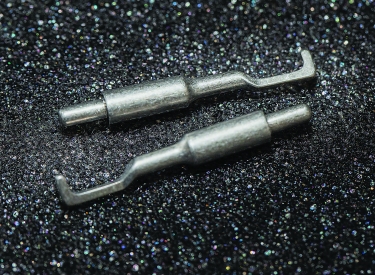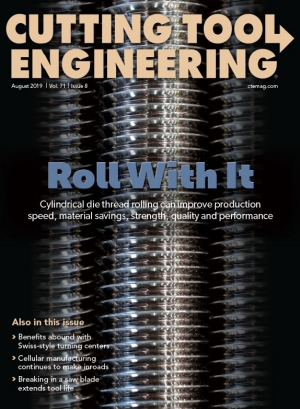Combining the power of Camarillo, California-based DP Technology Corp.’s Esprit CAM software and Windsor, Connecticut-based Tsugami/Rem Sales LLC’s Swiss-style machines has been a boon for MacKay Manufacturing Inc., reducing the time the company takes to machine complex parts.
Founded in 1986 in Spokane Valley, Washington, MacKay Manufacturing is a job shop that focuses on aerospace parts and surgical instruments and devices. The company has more than 135 employees and runs a two-year on-the-job training program to ensure that machinists get the experience needed to handle complicated projects.
At any given time, MacKay has between 400 and 600 work orders in progress. Job quantities can range from a one-off prototype part to several thousand pieces, machined in common metals like aluminum, titanium and stainless steel, as well as more exotic materials, such as ToughMet and ceramic plastics. The parts MacKay makes are typically complex and require tight tolerances, special certifications and efficient prototyping. MacKay places high emphasis on oversight, robust documentation control and production process tracking to assure customers that the correct raw materials have been purchased and are being machined properly during each step of the manufacturing process.

This Tsugami B0326-II machine tool is programmed with Esprit CAM software. Image courtesy of MacKay Manufacturing
MacKay’s production department runs almost 20 mills, including 11 5-axis LeBlond Makino horizontal machining centers, three Mori Seiki vertical mills and two Willemin-Macodel 408MTs. It also runs about two dozen lathes and Swiss-style turning machines, including three Tsugami 20mm Swiss-type screw machines with Iemca Boss 325 bar feeders; a Tsugami MU26; and five Tsugami 32mm Swiss-type turning centers with dual spindles, independent turrets, live tooling and thread whirling capability. The prototype department has six Mori Seiki vertical mills, two wire EDMs, three Bridgeport mills and a number of other machine tools.
To efficiently cut small parts, MacKay purchased its first Tsugami 20mm screw machine in 1998.
“We chose Tsugami because they have a reputation for being reliable, durable machines, and they’ve proved that to be true,” said Manufacturing Supervisor Gabe Compton. “We also chose Tsugami because of their excellent customer service and their relationship with the Tsugami/Rem Sales distributor Ellison Technologies, with whom we were already affiliated.”
MacKay began using Esprit in early 2010 on a Mori Seiki machine and now runs five seats of the CAM software to generate code for multiple machines, including the Tsugami lathes.
“Esprit solved an issue common to many shops: How can we get a better, more efficient program to the production floor and do it before the job is ready to start?” Compton said. “We are now able to preprogram the parts before they are scheduled to go into the machine. This has proved to be far more productive than programming the job at the machine, which takes up valuable time that could be used to manufacture parts. Now we have the tools staged and setup sheets created before the job is scheduled to run. We just have to load the code, set the tools and go.”
Pairing Esprit and Tsugami has made MacKay more efficient, helping it reduce lead times for customers.


These modified handles and adapters (left) were programmed with Esprit CAM software and machined on a Tsugami B0326-II machine tool. These L-tip parts (right), which are for a device used in endoscopic surgeries, also were programmed with Esprit and machined on a Tsugami B0326-II. Images courtesy of MacKay Manufacturing
“The Tsugami lathes allow us to meet the requirements for increased parts production,” Compton said. “Their relative ease of use and durability have given us the ability to meet growing demand.”
For example, MacKay makes a small L-tip part for an endoscopic surgery device. The company initially ran the part as a lathe blank, meaning that all the round features would be run before sending the part to the milling department to cut the L shape. The lathe blank ran for a minute and a half on a Tsugami BS20 and then for an additional five minutes on a mill.
In the years since taking on the project, MacKay has acquired new cutting tool technology and speeder heads. Combined with increased knowledge of what is possible on a Tsugami B0326-II CNC automatic lathe and in Esprit, the company felt confident enough in 2017 to make the part using only a B0326-II.
“We can now machine this part in under three minutes and make a far better part than we had previously,” Compton said. “We have since taken on two other parts in this part family and make them entirely on the lathe as well. We couldn’t have done this without Esprit and their technical support, nor could we have done this without the capability of the Tsugami lathe.”
For more information about MacKay Manufacturing’s work with Esprit CAM software, visit https://youtu.be/PRID86abZn4.
Contact Details
Contact Details
Related Glossary Terms
- centers
centers
Cone-shaped pins that support a workpiece by one or two ends during machining. The centers fit into holes drilled in the workpiece ends. Centers that turn with the workpiece are called “live” centers; those that do not are called “dead” centers.
- computer numerical control ( CNC)
computer numerical control ( CNC)
Microprocessor-based controller dedicated to a machine tool that permits the creation or modification of parts. Programmed numerical control activates the machine’s servos and spindle drives and controls the various machining operations. See DNC, direct numerical control; NC, numerical control.
- computer-aided manufacturing ( CAM)
computer-aided manufacturing ( CAM)
Use of computers to control machining and manufacturing processes.
- gang cutting ( milling)
gang cutting ( milling)
Machining with several cutters mounted on a single arbor, generally for simultaneous cutting.
- lathe
lathe
Turning machine capable of sawing, milling, grinding, gear-cutting, drilling, reaming, boring, threading, facing, chamfering, grooving, knurling, spinning, parting, necking, taper-cutting, and cam- and eccentric-cutting, as well as step- and straight-turning. Comes in a variety of forms, ranging from manual to semiautomatic to fully automatic, with major types being engine lathes, turning and contouring lathes, turret lathes and numerical-control lathes. The engine lathe consists of a headstock and spindle, tailstock, bed, carriage (complete with apron) and cross slides. Features include gear- (speed) and feed-selector levers, toolpost, compound rest, lead screw and reversing lead screw, threading dial and rapid-traverse lever. Special lathe types include through-the-spindle, camshaft and crankshaft, brake drum and rotor, spinning and gun-barrel machines. Toolroom and bench lathes are used for precision work; the former for tool-and-die work and similar tasks, the latter for small workpieces (instruments, watches), normally without a power feed. Models are typically designated according to their “swing,” or the largest-diameter workpiece that can be rotated; bed length, or the distance between centers; and horsepower generated. See turning machine.
- milling
milling
Machining operation in which metal or other material is removed by applying power to a rotating cutter. In vertical milling, the cutting tool is mounted vertically on the spindle. In horizontal milling, the cutting tool is mounted horizontally, either directly on the spindle or on an arbor. Horizontal milling is further broken down into conventional milling, where the cutter rotates opposite the direction of feed, or “up” into the workpiece; and climb milling, where the cutter rotates in the direction of feed, or “down” into the workpiece. Milling operations include plane or surface milling, endmilling, facemilling, angle milling, form milling and profiling.
- milling machine ( mill)
milling machine ( mill)
Runs endmills and arbor-mounted milling cutters. Features include a head with a spindle that drives the cutters; a column, knee and table that provide motion in the three Cartesian axes; and a base that supports the components and houses the cutting-fluid pump and reservoir. The work is mounted on the table and fed into the rotating cutter or endmill to accomplish the milling steps; vertical milling machines also feed endmills into the work by means of a spindle-mounted quill. Models range from small manual machines to big bed-type and duplex mills. All take one of three basic forms: vertical, horizontal or convertible horizontal/vertical. Vertical machines may be knee-type (the table is mounted on a knee that can be elevated) or bed-type (the table is securely supported and only moves horizontally). In general, horizontal machines are bigger and more powerful, while vertical machines are lighter but more versatile and easier to set up and operate.
- turning
turning
Workpiece is held in a chuck, mounted on a face plate or secured between centers and rotated while a cutting tool, normally a single-point tool, is fed into it along its periphery or across its end or face. Takes the form of straight turning (cutting along the periphery of the workpiece); taper turning (creating a taper); step turning (turning different-size diameters on the same work); chamfering (beveling an edge or shoulder); facing (cutting on an end); turning threads (usually external but can be internal); roughing (high-volume metal removal); and finishing (final light cuts). Performed on lathes, turning centers, chucking machines, automatic screw machines and similar machines.











